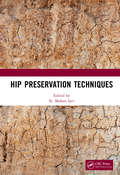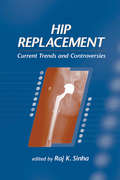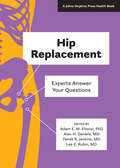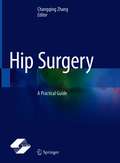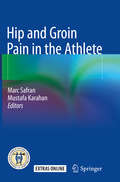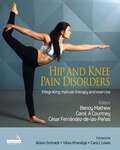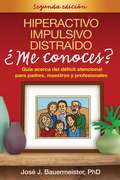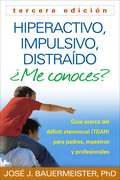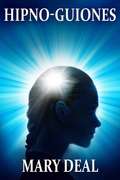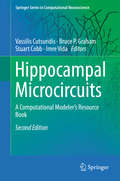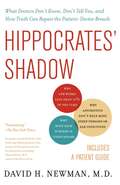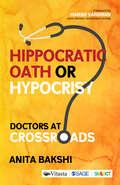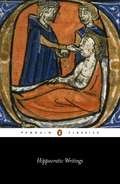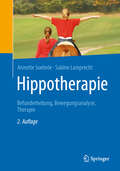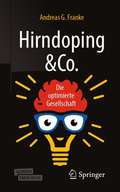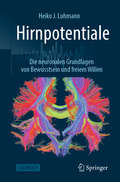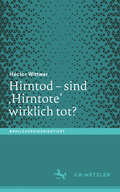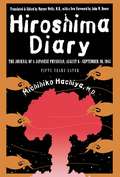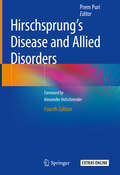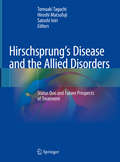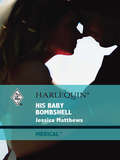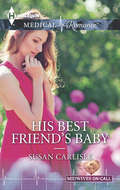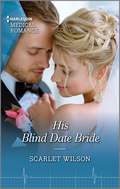- Table View
- List View
Hip Preservation Techniques
by K. Mohan IyerHip Preservation Techniques explores hip problems and presents and compares alternative protocols for treating the condition in children, adolescents, young adults, and adults. While poor long-term outcomes of arthroplasty have led to an increasing dependence on procedures to conserve the native hip, preservation surgery may maintain or protect a hip and prevent or delay the need for arthroplasty. Well-established techniques such as cartilage restoration and use of tissue-derived mesenchymal stem cells are presented, and conceptually different procedures such as Bernese peri-acetabular osteotomy, Salter’s and Pemberton’s osteotomy are also discussed. This book will be useful for medical students, residents and consultants with an interest in hip preservation surgery. Key Features Explores the emerging concepts in hip preservation surgery with a concise and to-the-point approach Discusses digital templating in total hip arthroplasty Examines the anterior approach to the hip for a minimally invasive prosthesis Offers a comprehensive coverage of the topic through beautiful illustrations
Hip Prosthesis: CAD Modeling, Finite Element Analysis (FEA) and Compressive Load Testing (SpringerBriefs in Applied Sciences and Technology)
by Solehuddin Shuib Najwa Syakirah Hamizan Amir Radzi Ab GhaniThis book highlights the critical challenge of improving the design and performance of hip implants, which are essential for enhancing patient outcomes in hip replacement surgeries. The book focuses on utilizing Finite Element Analysis (FEA) to optimize implant designs, ensuring they can withstand complex mechanical loads and reduce the risk of failure. It is hoped that readers will gain a deeper understanding of the significance of implant design and the role of FEA in predicting and enhancing implant performance, ultimately leading to better, more durable solutions in orthopedic surgeries.
Hip Replacement: Current Trends and Controversies
by Raj K. SinhaHip Replacement offers useful strategies to choose the appropriate biomaterials and implant structure avoid complications in hip replacement surgery analyze the bone-biomaterial interface perform difficult hip reconstructions track in vivo performance of hip prosthetics inhibi
Hip Replacement: Experts Answer Your Questions (A Johns Hopkins Press Health Book)
by Adam E. M. EltoraiA quick yet comprehensive guide for anyone considering hip replacement surgery.Each year, more than 300,000 adults in the United States undergo hip replacement surgery. What can the many people experiencing hip pain in this country expect before, during, and after surgery? Hip Replacement—part of a new series of Johns Hopkins University Press books on specific surgical procedures—is designed to provide quick answers to all of the most common questions individuals have about hip surgery and the recovery process. Focusing on the patient experience, this frank and easy-to-use book highlights real patient experiences with hip pain, diagnosis, and treatment. The book • discusses basic hip anatomy • describes the symptoms of hip arthritis • explores alternative treatments, including lifestyle changes, medications, and surgical treatments other than hip replacement • reviews the entire recovery process, including preferred exercises to help speed your recovery and how quickly you can return to certain activities• features a glossary of key terms and a list of frequently asked questions • contains numerous sidebars touching on important points to consider, questions to ask your doctor, red flags, and risks • is supplemented with useful illustrations and photographsThe book's concise format allows readers to peruse the content quickly in the days leading up to surgery and then refer to it during the recovery period. Written by experts in the field, Hip Replacement is destined to become the most trusted book on this topic. Contributors: Roy K. Aaron, MD, Valentin Antoci, Jr., MD, PhD, Travis Blood, MD, Eric Cohen, MD, Matthew E. Deren, MD, John Froehlich, MD, MBA, Derek R. Jenkins, MD, Dominic T. Kleinhenz, MD, Scott Ritterman, MD, Lee E. Rubin, MD
Hip Surgery: A Practical Guide
by Changqing ZhangThis book discusses disorders affecting the hip joint as well as its related structures, to help orthopedists develop an integrated way of thinking, and improve their decision-making strategies and treatment skills. The specific anatomy of the hip joint and the related structures provides vital motor functions. It also presents a challenge for orthopedists in terms of early diagnosis of disorders, which is essential for appropriate and effective treatment. The first part of the book provides a step-by-step introduction to intra-articular and abarticular hip disorders in both adults and children. It then describes the techniques and practicalities of managing various conditions in detail, presenting stereoscopic chromatic line drawings along with intraoperative illustrated figures. By demonstrating the regional anatomy, pathophysiology and related disorders in hip region, this book helps readers gain an understanding based on basic science and clinical research. It also offers instructive guidance to learners at different levels, including orthopedists, general practitioners and rehabilitation practitioners.
Hip and Groin Pain in the Athlete
by Mustafa Karahan Marc SafranThis book presents the latest knowledge in the evaluation and management of hip- and groin-related injuries in athletes. Techniques of hip arthroscopy, as well as their limitations and possible complications, are clearly described, and guidance is provided on the use of periarticular hip endoscopy in patients with periarticular problems. A series of chapters address the potential approaches in the various conditions that may be encountered in athletes, including femoroacetabular impingement, athletic pubalgia, chondral and labral injuries, and hip instability by world renowned experts in the field. Considerations in particular age groups, especially adolescents, are highlighted. Rehabilitation is discussed in detail, and a concluding chapter examines emerging perspectives on the management of hip injuries. The book is published in collaboration with ISAKOS and combines the international expertise of ISAKOS members renowned for their management of injuries to the hip and groin. Hip and Groin Pain in the Athlete will be a must-read for team physicians and all clinicians who treat athletes.
Hip and Knee Pain Disorders: An evidence-informed and clinical-based approach integrating manual therapy and exercise
by VariousHip and Knee Pain Disorders has been written to provide a state-of-the-art, evidence-informed and clinically-informed overview of the examination and conservative management of hip/knee pain conditions. Under the current predominantly evidence-based practice paradigm, clinician expertise, patient preference, and best available research determine examination, and prognostic and clinical management decisions. However, this paradigm has been understood by many to place greater value and emphasis on the research component, thereby devaluing the other two. Evidence-informed practice is a term that has been suggested to honor the original intent of evidence-based practice, while also acknowledging the value of clinician experience and expertise. In essence, evidence-informed practice combines clinical reasoning, based on current best evidence, with authority-based knowledge and a pathophysiological rationale derived from extrapolation of basic science knowledge. Unlike other published textbooks that overemphasize the research component in decision-making, this book aims to address the clinical reality of having to make decisions on the management of a patient with hip/knee pain, in the absence of a comprehensive scientific rationale, using other sources of knowledge. It offers an evidence-informed textbook that values equally research evidence, clinician expertise and patient preference.The book is edited by three recognised world leaders in clinical research into manual therapy and chronic pain. Their research activities are concentrated on the evidence-based management of musculoskeletal pain conditions using conservative interventions. For this book they have combined their knowledge and clinical expertise with that of 38 additional contributors, all specialists in the field The contributors include a mix of clinicians and clinician-researchers.Hip and Knee Pain Disorders is unique in bringing together manual therapies and exercise programs in a multimodal approach to the management of these pain conditions from both a clinical, but also evidence-based, perspective. It acknowledges the expanding direct access role of the physical therapy profession. The book provides an important reference source for clinicians of all professions interested in conservative management of the hip and knee regions. It will also be useful as a textbook for students at both entry and post-graduate level.
Hiperactivo, Impulsivo, Distraído ¿Me conoces?, Segunda edición
by José J. BauermeisterEscrita específicamente para los padres y los maestros de habla hispana, esta guía práctica y realista ofrece consejos esenciales para ayudar a los niños con el TDA o el TDAH. El destacado experto, Dr. José J. Bauermeister, extrae los conocimientos científicos más recientes sobre estos problemas y describe medidas claras que se pueden tomar para reforzar las habilidades de su niño, encontrar los tratamientos apropiados, promover el éxito escolar y mejorar su comportamiento tanto en la casa como en la escuela. A lo largo de su carrera, el Dr. Bauermeister se ha dedicado a trabajar con niños y familias hispanas, cuyas experiencias y cultura únicas están reflejadas en cada página. El contenido especial de esta edición incluye la información más actualizada sobre los medicamentos y cuándo (y cuándo no) se deben usar; el problema del TDAH en las niñas, frecuentemente pasado por alto; cómo explicar el trastorno a los niños; consejos para aumentar la autoestima, y mucho más. Written specifically for Spanish-speaking parents and teachers, this practical, down-to-earth resource offers essential guidance for helping children with ADD or ADHD. Leading expert Dr. José J. Bauermeister distills the latest scientific knowledge about these problems and describes clear steps you can take to build on your child's strengths, find the right treatments, promote school success, and improve behavior both at home and in school. Dr. Bauermeister has devoted his career to working with Hispanic children and families, whose unique experiences and culture are reflected on every page. Special features of this edition include the latest information on medications and when (and when not) to use them, the often-overlooked problem of ADHD in girls, how to explain the disorder to kids, tips to increase self-esteem, and much more.
Hiperactivo, Impulsivo, Distraído ¿Me conoces?, Tercera edición
by Russell A. Barkley José J. BauermeisterSi su hijo ha recibido un diagnóstico del trastorno por déficit de atención con hiperactividad (TDAH), usted necesita orientación y apoyo en los que pueda confiar. Ha llegado al lugar correcto. Uno de los principales expertos, el Dr. José J. Bauermeister, explica, con claridad, la naturaleza de los problemas de atención y las razones por las que los niños con estos trastornos actúan como lo hacen. Usted aprenderá estrategias cuya eficacia ha sido comprobada para superar los frustrantes problemas de la conducta, para ayudar a su hijo a tener éxito en la escuela y, de ser necesario, para encontrar la ayuda profesional adecuada. El Dr. Bauermeister ha dedicado su carrera a trabajar con niños hispanos y con familias hispanas cuyas experiencias y culturas distintivas se reflejan en cada página. Escrito en español (no traducido), este libro es un recurso único para ayudarlo(a) a usted a satisfacer las necesidades de su hijo. Además, proporciona información esencial para maestros y otros profesionales. Esta tercera edición, revisada y actualizada, incluye la investigación científica y las estrategias de tratamiento más recientes. If your child has been diagnosed with attention-deficit/hyperactivity disorder (ADHD), you need guidance and support that you can trust. You've come to the right place. Leading expert Dr. José J. Bauermeister clearly explains the nature of attention problems and why children with these disorders act the way they do. You'll learn proven strategies for overcoming frustrating behavior problems, helping your son or daughter succeed in school, and, if needed, finding the right professional help. Dr. Bauermeister has devoted his career to working with Hispanic children and families, whose unique experiences and culture are reflected on every page. Written in Spanish (not a translation), this is a unique resource to help you meet the needs of your child. It also provides essential information for teachers and other professionals. Revised and updated, the third edition includes the latest scientific research and treatment strategies.
Hipno-Guiones: Técnicas que cambian la vida utilizando la autohipnosis y la meditación
by Mary Deal¿Le gustaría tener el poder de convertirse en todo lo que puede ser? Toda programación bien intencionada funciona mejor cuando alcanza un estado mental más profundo. El secreto está en acceder a esos estados a través de técnicas fáciles que cambian la vida. Una delgada ventana de conciencia diferencia dos estados de la mente: autohipnosis y meditación, y este libro mostrará sus similitudes y definirá cada condición y accesibilidad. Si tiene la curiosidad de al menos leer detenidamente este libro, entonces la capacidad de aprender estas técnicas ya es parte de su conciencia y pronto será reconocida. ¡Es afortunado! Su subconsciente lo incita a investigar. Está diciendo que es capaz de tener estados mentales más profundos. Muchos han tratado de concentrarse para aprender la autohipnosis o la meditación y han fallado. La concentración aplicada y saber qué esperar una vez cautivado puede ser lo que faltaba. Las instrucciones en este libro están destinadas a aquellos que deseen aprender y usar las técnicas de autohipnosis y/o meditación para la superación personal. Se proporcionan guiones fáciles pero potentes para producir los cambios deseados. Puede cambiar su vida hoy.
Hippocampal Microcircuits: A Computational Modeler's Resource Book (Springer Series in Computational Neuroscience #5)
by Vassilis Cutsuridis Bruce P. Graham Stuart Cobb Imre VidaThis is the 2nd edition of a very well received and popular book that reflects the current state-of-the-art of the ongoing research avenues concerning the hippocampus and processing units bridging the gap between single cell activity, network activity and global brain function. It aims to provide a methodology to anyone interested in developing microcircuit level models of the hippocampus. <P><P> The book is divided into two thematic areas: (I) Experimental background and (II) Computational analysis. In part I, leading experimental neuroscientists discuss the morphological, physiological and molecular characteristics as well as the connectivity and synaptic properties of the various cell types found in the hippocampus. Behaviour-related ensemble activity patterns of morphologically identified neurons in anesthetized and freely moving animals provide insights on the function of the hippocampal areas. In part II, computational neuroscientists present models of the hippocampal microcircuits at various levels of detail (e.g. single cell level, network level, etc.). Synaptomics and connectomics models of hippocampal structures are initially discussed. Then, network models of memory, rhythm generation and spatial navigation are presented, followed by abstract and biophysical models of synaptic plasticity. Network models of hippocampal implicated disorders (epilepsy and schizophrenia) are then detailed and how their network topologies, connectivities and activities change in these diseases. Finally, two chapters are dedicated to describing simulator environments of single neurons and networks currently used by computational neuroscientists in developing their models and modelling tools to parametrically constrain them. <P><P> This engaging volume is invaluable to experimental and computational neuroscientists, electrical engineers, physicists, mathematicians and others interested in developing microcircuit models of the hippocampus. Graduate level students and trainees in all of these fields can find this book a significant source of information.
Hippocrates' Shadow
by David H NewmanEveryone knows of the Hippocratic Oath, the famous invocation sworn by all neophyte physicians. But most don't realize that the father of modern medicine was an avid listener and a constant bedside presence. Hippocrates believed in the doctor-patient connection and gained worldwide renown for championing science over mysticism while respecting and advocating the potency of human healing. Today, argues Dr. David H. Newman, medicine focuses narrowly on the rewards of technology and science, exaggerating their benefits and ignoring or minimizing their perils. Dr. Newman sees a disconnect between doctor and patient, a disregard for the healing power of the bond, and, ultimately, a disconnect between doctors and their Oath. The root of this divergence, writes Dr. Newman, lies in the patterns of secrecy and habit that characterize the "House of Medicine," modern medicine's entrenched and carefully protected subculture. In reflexive, often unconscious defense of this subculture, doctors and patients guard medical authority, cling to tradition, and yield to demands that they do something or prescribe something. The result is a biomedical culture that routinely engages in unnecessary and inefficient practices, and leaves both patient and doctor dissatisfied. While demonstrating an abiding respect for, and a deep understanding of, the import of modern science, Dr. Newman reviews research that refutes common and accepted medical wisdom. He cites studies that show how mammograms may cause more harm than good; why antibiotics for sore throats are virtually always unnecessary and therefore dangerous; how cough syrup is rarely more effective than a sugar pill; the power and paradox of the placebo effect; how statistics and studies themselves are frequently deceptive; and why CPR is violent, invasive -- and almost always futile. Through an engaging, deeply researched, and eloquent narrative laced with rich and riveting case studies, Newman cuts to the heart of what really works -- and doesn't -- in medicine and rebuilds the bridge between physicians and their patients.
Hippocratic Oath or Hypocrisy?: Doctors at Crossroads
by Anita Sikand BakshiMedicine was until recently a greatly respected profession supported by trust and faith on one side and compassion and care on the other. However, over the years, the relationship between doctors and patients has suffered. Doctors now find themselves in the news for all the wrong reasons. Labelled as ‘murderers’, ‘knife happy’, ‘organ stealing thieves’ or touts of pharmaceutical giants, they have now lost respect in the eyes of society. When and how did this happen? When did doctors go from being ‘Next to God’ to maut ke saudagar, as the media is so fond of labelling them? Hippocratic Oath or Hypocrisy?: Doctors at Crossroads is the author’s journey as a doctor over three decades, from a young medical student to an experienced paediatrician. She has used her experience to highlight serious issues—demanding patients, prescribing of unnecessary investigations, hospitals run like business houses, the role of big pharmaceutical industries and so on from the point of view of both doctors and patients. The author’s anecdotal style, which includes quotes from her many case studies, will keep the reader turning the pages eagerly till the end.
Hippocratic Writings
by HippocratesThis work is a sampling of the Hippocratic Corpus, a collection of ancient Greek medical works. At the beginning, and interspersed throughout, there are discussions on the philosophy of being a physician. There is a large section about how to treat limb fractures, and the section called The Nature of Man describes the physiological theories of the time. The book ends with a discussion of embryology and a brief anatomical description of the heart.
Hippotherapie: Befunderhebung, Bewegungsanalyse, Therapie
by Annette Soehnle Sabine LamprechtDieses Praxisbuch gibt einen umfassenden Überblick über Grundlagen, Durchführung und Indikationen dieser effektiven Therapieform. Die differenzierte Bewegungsanalyse von Mensch und Tier sowie deren Wechselwirkung zueinander stehen im Mittelpunkt und werden aus therapeutischer Sicht detailliert erörtert. Konkrete Fallbeispiele veranschaulichen den Komplex Pferd-Patient mit all seinen Facetten und schaffen das ideale Fundament für die spezifische praktische Anwendung.• Welchen Anforderungen müssen Pferd und Infrastruktur entsprechen?• Welche Patienten eignen sich zur hippotherapeutischen Behandlung?• Welche rechtlichen Rahmenbedingungen gilt es zu beachten?Finden Sie Antworten auf diese und viele weitere spannende Fragen und rüsten Sie sich optimal für diese hervorragende Therapieform mit dem Pferd.
Hirndoping & Co.: Die optimierte Gesellschaft
by Andreas G. FrankeLeistungssteigerung per Pille oder kurz „Hirndoping“ ist zu einem regelrechten Trend geworden, der innerhalb weniger Jahre besorgniserregende Ausmaße angenommen hat. Doch wie kommt das?Das Buch beleuchtet das brisante Thema „Hirndoping" erstmals aus zahlreichen Blickwinkeln wie Soziologie, Medizin, Sport- und Rechtswissenschaften und vielen weiteren Disziplinen.Es zeichnet den Weg von der Agrargesellschaft, in der die Geschwindigkeit des Lebens von den natürlichen Gegebenheiten abhing, bis in die heutige Zeit nach. Eine Zeit, in der es durch Globalisierung und Digitalisierung vermeintlich keine Grenzen mehr gibt. Die letzte Grenze, die es zu überwinden gilt, scheint unser Geist. „Hirndoping“ bietet sich hier als Antwort aus den Regalen der Arzneimittelindustrie an. Eine Antwort, die aber nur begrenzt funktioniert und die gesundheitlich, juristisch und ethisch nicht frei von Risiken und Nebenwirkungen ist. Alternativlos ist „Hirndoping“ jedenfalls nicht.
Hirnpotentiale: Die neuronalen Grundlagen von Bewusstsein und freiem Willen
by Heiko J. LuhmannDer Neurophysiologe Heiko Luhmann erforscht seit mehr als 35 Jahren die Funktionsweise von Nervenzellen und neuronalen Netzen. In diesem spannenden und provozierenden Buch informiert er Sie über die neuesten Erkenntnisse der Hirnforschung und wie diese unsere Vorstellungen über das Bewusstsein und den freien Willen verändern. Sie erfahren, dass die Trennung von Körper und Geist aus neurowissenschaftlicher Sicht nicht aufrechterhalten werden kann und wie unterschiedliche Wissenschaftsdisziplinen ein neues Konzept zur Funktionsweise unseres Gehirns entwickeln. Das Buch beschäftigt sich mit spannenden grundlegenden Fragen, wie:Warum gibt es überhaupt Gehirne? Wie kommt die Welt in den Kopf? Wie sind interne neuronale Karten aufgebaut? Wo ist das Bewusstsein lokalisiert und wie entsteht es? Hat der Oktopus ein Bewusstsein? Ist das Gehirn eine Prädiktionsmaschine? Erlaubt das Konzept der prädiktiven Kodierung einen freien Willen? Entwickeln wir mit Hilfe eines Hirn-Computer-Interfaces ein höheres Bewusstein? Sind wir technologisch in der Lage Gedanken zu lesen und zu erzeugen? Verfügen Roboter eines Tages über ein künstliches Bewusstsein?
Hirntod – sind ‚Hirntote‘ wirklich tot? (#philosophieorientiert)
by Héctor WittwerDas Buch bietet den ersten deutschsprachigen Überblick über die Hirntoddebatte. Dabei geht es um die Frage, ob Patienten, bei denen der vollständige und unumkehrbare Ausfall der Hirnfunktionen diagnostiziert wurde, tot oder lebendig sind. Nicht nur in Deutschland gilt der Hirntod heute als medizinisches und rechtliches Kriterium für den Eintritt des menschlichen Todes. Die Frage nach der Richtigkeit des Hirntodkriteriums ist nicht nur von theoretischem Interesse. Vielmehr kommt ihr deshalb eine besondere praktische Relevanz zu, im Kontext der Organtransplantation fast überall die sog. Totspenderregel gilt, d.h., Organe für die Transplantation dürfen (mit wenigen Ausnahmen) nur Toten entnommen werden. Allerdings mehren sich seit den 2000er Jahren Zweifel an der Richtigkeit dieses Kriteriums. Empirische Befunde zeigen, dass bei den sog. Hirntoten zahlreiche Lebensfunktionen intakt sind, obwohl diese nicht mehr vom Gehirn gesteuert werden. ‚Hirntote‘ können z.B. wachsen, die Geschlechtsreife erreichen oder ein Kind austragen. Diese Feststellung lässt vermuten, dass das Gehirn für die Aufrechterhaltung der Vitalfunktionen nicht so wichtig ist, wie die Verfechter des Hirntodkriteriums annehmen. Man kann weiterhin fragen, ob typische Merkmale von ‚Hirntoten‘ mit dem allgemein anerkannten Verständnis des Begriffs ‚Tod‘ vereinbar sind. Damit man ihnen Organe für die Transplantation entnehmen kann, müssen Hirntote beispielsweise künstlich ernährt werden. Kann man ohne Widerspruch behaupten, dass ein Organismus einerseits tot ist und dass er andererseits Nahrung benötigt, künstlich ernährt wird und einen Stoffwechsel mit seiner Umwelt vollzieht? Der Autor stellt alle geläufigen Argumente für und gegen die Angemessenheit des Hirntodkriteriums dar und prüft diese kritisch. Er vertritt die These, dass die Auffassung, hirntote Patienten seien tot, unhaltbar ist.
Hiroshima Diary
by Michihiko HachiyaThe late Dr. Michihiko Hachiya was director of the Hiroshima Communications Hospital when the world's first atomic bomb was dropped on the city. Though his responsibilities in the appalling chaos of a devastated city were awesome, he found time to record the story daily, with compassion and tenderness. His compelling diary was originally published by the UNC Press in 1955, with the help of Dr. Warner Wells of the University of North Carolina at Chapel Hill, who was a surgical consultant to the Atomic Bomb Casualty Commission and who became a friend of Dr. Hachiya. In a new foreword, John Dower reflects on the enduring importance of the diary fifty years after the bombing.
Hirsch and Brenner's Atlas of EEG in Critical Care
by Lawrence J. Hirsch Richard P. Brenner Michael W. FongAtlas of EEG in CRITICAL CARE An essential resource enabling the rapid detection of clinically relevant EEG patterns in the ICU setting In the newly revised Second Edition of Atlas of EEG in Critical Care, a team of distinguished medical professionals deliver a highly illustrated, accessible, and authoritative guide to EEGs in critically ill patients. The book highlights key diagnostic patterns, enabling clinicians to make rapid, accurate diagnoses of all major critical conditions, including seizures, stroke, and coma. The authors offer up-to-date coverage of continuous and quantitative EEG methods, including explanations of the American Clinical Neurophysiology Society’s 2021 Terminology for Critical Care EEG. The new edition provides readers with a wide range of presentations seen in typical intensive care units and utilizes extensive color arrows and boxes to highlight the patterns in EEG traces. It explores methods of data management and trending that are central to long-term monitoring and covers invasive recordings, including multi-modal monitoring. Readers will also find: Thorough introductions to the basics of EEG and EEG in encephalopathy In-depth explorations of seizures and status epilepticus, as well as rhythmic and periodic patterns, the ictal-interictal continuum, the extreme delta brush pattern, and other controversial and recently defined EEG patterns Comprehensive discussions of EEG in encephalopathy, coma, and cerebrovascular disease, as well as artifacts that can mimic seizures and other physiologic patterns Numerous examples of prolonged EEG monitoring and an in-depth section on quantitative EEG techniques for detection of seizures and ischemia Perfect for neurologists, EEG’ers and neurointensivists, the latest edition of Atlas of EEG in Critical Care will also earn a place in the libraries of neurology trainees seeking a practical and accessible collection of EEG traces from intensive care patients.
Hirschsprung's Disease and Allied Disorders
by Prem PuriThis is the third edition of a comprehensive study of the neuronal disorders of the lower gastrointestinal tract in children. Important new studies and progress in research on bowel motility and motility disorders are covered in detail as well as new aspects concerning the embryology, functional anatomy of the enteric nervous system. In particular new insights have been received from the studies in the genetics of Hirschsprung's disease. Special emphasis is laid on new surgical techniques, especially on the laparoscopic approach in combination with Soave's or Duhamel's technique.
Hirschsprung’s Disease and the Allied Disorders: Status Quo and Future Prospects of Treatment
by Tomoaki Taguchi Hiroshi Matsufuji Satoshi IeiriThis book provides essential information on the status quo and changing profile of Hirschsprung’s disease and allied disorders. Hirschsprung’s disease is a common cause of neonatal intestinal obstruction and one of the most important and most fascinating diseases in pediatric surgery throughout the world. Currently, the diagnosis and treatment of Hirschsprung’s disease and allied disorders are in a state of constant development. Written by expert pediatric surgeons, Hirschsprung’s Disease and the Allied Disorders presents state-of-the-art information, such as new genetic evidence, and historical operative techniques that were less invasive and resulted in fewer follow-up operations. It offers a highly informative guide that will greatly benefit all readers engaged in pediatric medicine, pediatric surgeons, and the medical staff of NICUs around the globe.
His Baby Bombshell
by Jessica MatthewsNurse Sabrina Hollister is a single mother with a young baby to support. The last thing she needs is for her ex-lover--the father of her child--to turn up as her temporary boss! She cannot forgive Adrian McReynolds for breaking her heart. . . nor can she forgive herself for not telling him about their son. Adrian is knocked out by Sabrina's little secret. There's no way he'll let her raise their son alone. He was foolish enough to let Sabrina slip away before--he won't let it happen again!
His Best Friend's Baby (Midwives On-Call #6)
by Susan CarlislePregnant on his doorstep! Former army medic Ryan Matthews loves his work as a midwife-bringing life into the world helps him forget losing his best friend in Iraq. But when Ryan finds his friend's pregnant wife on his doorstep, his whole world is turned upside down... For Ryan, opening his door to Phoebe is one thing-but opening his heart is a whole different matter. Until one scorching, unforgettable kiss unleashes emotions he locked away long ago...and Ryan finds himself fighting against a love he's never dared to believe exists!
His Blind Date Bride: His Blind Date Bride / Second Chance In Barcelona (Mills And Boon Medical Ser.)
by Scarlet WilsonA missed blind date……leads to a chance at forever!After exchanging messages for months via a dating app, surgeon Ivy Ross is finally ready to meet up with “Mr. Right.” But when work calls her away the chance is lost…until fate intervenes and Ivy’s blind date—Travis King—arrives as her new senior medical officer…aka her boss! Travis and Ivy know mixing business and pleasure is a bad idea, but sometimes bad ideas feel so good…From Harlequin Medical: Life and love in the world of modern medicine.
